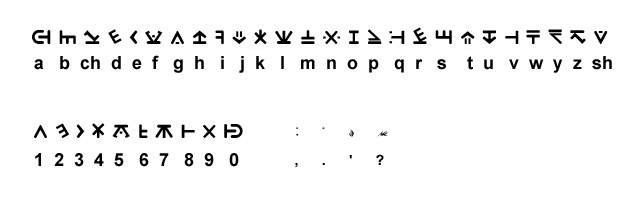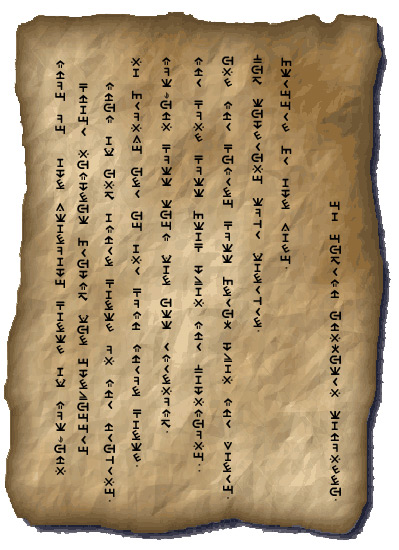Laudean/Language: Difference between revisions
(Added pronouns) |
m (m118) |
||
| (5 intermediate revisions by 4 users not shown) | |||
| Line 1: | Line 1: | ||
{{M118}} | |||
{{Memory118TOC}} | |||
{{UC}} | |||
{{Laudean}} | {{Laudean}} | ||
==Linguistics and Etymology== | ==Linguistics and Etymology== | ||
| Line 20: | Line 23: | ||
===People and Families=== | ===People and Families=== | ||
As the Laudean species possesses a third sex they possess a third pronoun and a third category of family identifiers. Originally the third category was mapped to the | As the Laudean species possesses a third sex they possess a third pronoun and a third category of family identifiers. Originally the third category was mapped to the corresponding male words in Federation Standard due to a misunderstanding of the relationships and function of the three sexes, but it is now recognized that these words have no equivalent in Federation Standard and should be used in their original form. | ||
Part of this misunderstanding derived from the word 'lomale', which was thought to indicate a 'secondary male' status, however it was later | Part of this misunderstanding derived from the word 'lomale', which was thought to indicate a 'secondary male' status, however it was later realized to be a simple linguistic coincidence. 'Lomale' is the Laudean word for their third sex; the Laudean word for male 'Toshale'. | ||
{| border='2' cellspacing='0' | {| border='2' cellspacing='0' | ||
| Line 46: | Line 49: | ||
!His/Hers | !His/Hers | ||
!Jhoes | !Jhoes | ||
! | !Jhais | ||
!Jheas | !Jheas | ||
|- | |- | ||
| Line 56: | Line 59: | ||
|} | |} | ||
==Tenses== | |||
[[Laudean Tenses|How to conjugate verbs in different tenses of Laudean]] | |||
Ancient Laudean was lost for thousands of years, and only rediscovered recently by Professor Anson Robertson of the Federation Embassy. It consists of 10 numerical digits (0 through 9), and 26 alphabetic characters. Unlike "English", however, only 24 are traditional "letters" (missing the "c" and "x"), while two are actually consonant blends ("ch" and "sh"). As well, only four punctuation marks have been discovered so far. | |||
[[Image:Anc laudean lang.jpg]]<br><br><br> | |||
[[ | |||
[[Image:Ancient laudean example.jpg|right]]Ancient Laudean was written vertically, from left to right, not horizontally. Each "column" was considered a complete thought...a sentence. If a sentence was too long to fit on the medium and needed to be continued there would be a small space at the top of the next column (ie. an "indent") and the sentence would continue on from there. | |||
Genitive (Of, relating to, or being the grammatical case expressing possession, measurement, or source) and compound words (a form of the genitive) were created by compounding the two words together using a ''chil'' (their word for "apostrophe"). | |||
*Example: snowman (man of snow) - jiu'su'lade | |||
*Example: daylight (light of day) - rei'falo | |||
[[Category:Laudean Language]] | [[Category:Laudean Language]] | ||
Latest revision as of 05:16, 22 January 2020
| Memory 118 |
|---|
| Memory 118 Guide • Full Index • A B C D E F G H I J K L M N O P Q R S T U V W X Y Z |
| This article is undergoing an expansion or major revamping. However, you are welcome to assist in its construction by editing it as well. Comments regarding possible improvements are welcome on the articles talk page. |

|
| Laudeans |
|
|
Linguistics and Etymology
Glossary of Terms
- pletrok = n. fabulous equine beast with a long spiraled horn jutting from the middle of its forehead. It is often considered as a composite creature, having the features of various animals. The pletrok is depicted as a beautiful animal, usually pure white in color. It has been used to represent virginity, but also as a metaphor representing strength, chaste love and faithful marriage.
- sh'tla = n. blanket, cover.
Ancient Laudean
Ancient Laudean was lost for thousands of years, and only rediscovered recently by Professor Anson Robertson of the Federation Embassy. It consists of 10 numerical digits (0 through 9), and 26 alphabetic characters. Unlike "English", however, only 24 are traditional "letters" (missing the "c" and "x"), while two are actually consonant blends ("ch" and "sh"). As well, only four punctuation marks have been discovered so far.
Dictionary/Vocab
Click here for:
The Laudean is given after the English word
People and Families
As the Laudean species possesses a third sex they possess a third pronoun and a third category of family identifiers. Originally the third category was mapped to the corresponding male words in Federation Standard due to a misunderstanding of the relationships and function of the three sexes, but it is now recognized that these words have no equivalent in Federation Standard and should be used in their original form.
Part of this misunderstanding derived from the word 'lomale', which was thought to indicate a 'secondary male' status, however it was later realized to be a simple linguistic coincidence. 'Lomale' is the Laudean word for their third sex; the Laudean word for male 'Toshale'.
| ||||||||||||||||||||||||
|---|---|---|---|---|---|---|---|---|---|---|---|---|---|---|---|---|---|---|---|---|---|---|---|---|
Tenses
How to conjugate verbs in different tenses of Laudean
Ancient Laudean was lost for thousands of years, and only rediscovered recently by Professor Anson Robertson of the Federation Embassy. It consists of 10 numerical digits (0 through 9), and 26 alphabetic characters. Unlike "English", however, only 24 are traditional "letters" (missing the "c" and "x"), while two are actually consonant blends ("ch" and "sh"). As well, only four punctuation marks have been discovered so far.

Ancient Laudean was written vertically, from left to right, not horizontally. Each "column" was considered a complete thought...a sentence. If a sentence was too long to fit on the medium and needed to be continued there would be a small space at the top of the next column (ie. an "indent") and the sentence would continue on from there.
Genitive (Of, relating to, or being the grammatical case expressing possession, measurement, or source) and compound words (a form of the genitive) were created by compounding the two words together using a chil (their word for "apostrophe").
- Example: snowman (man of snow) - jiu'su'lade
- Example: daylight (light of day) - rei'falo
